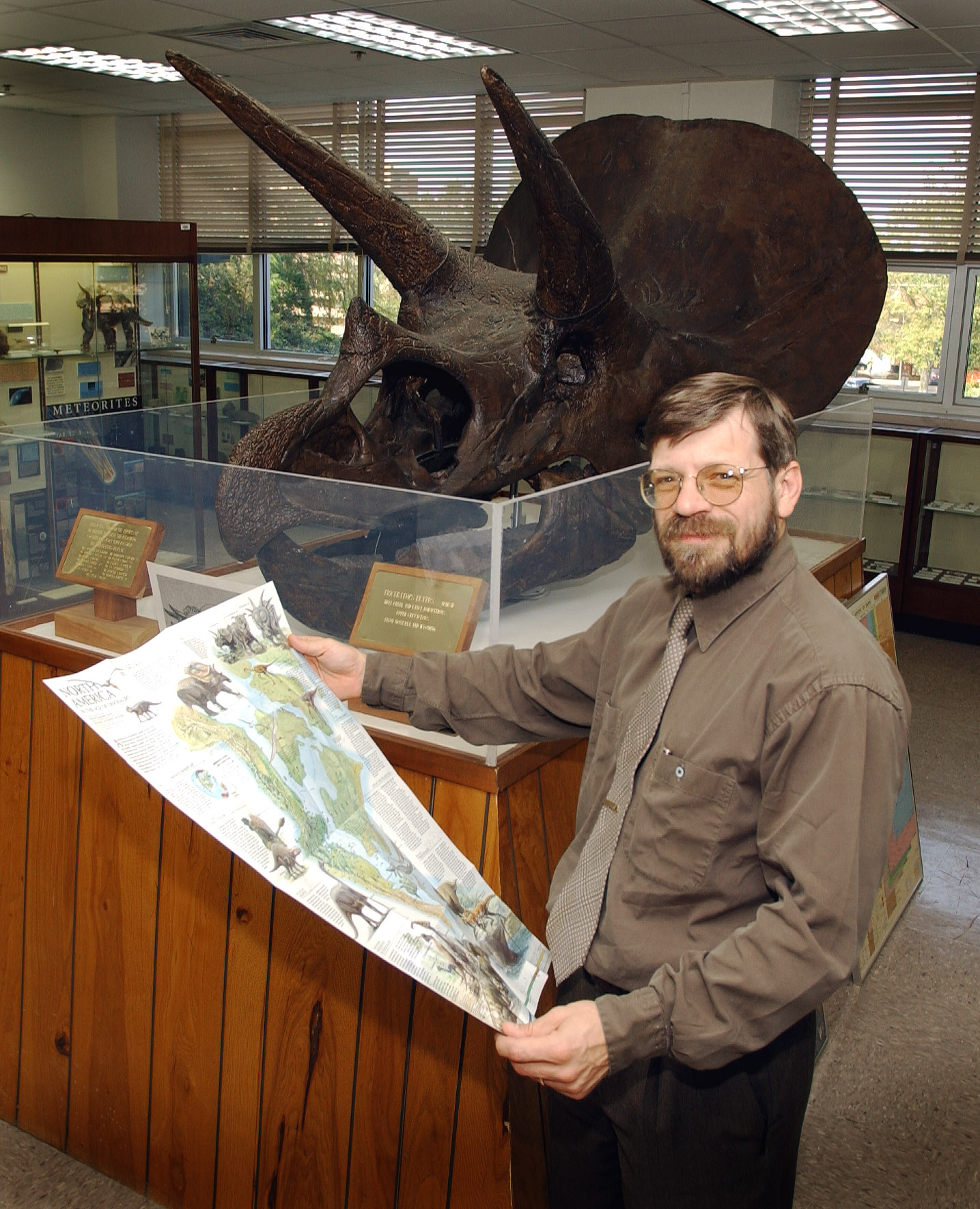Contact: Phil Hearn

Chris Dewey and triceratops in MSU's Dunn-Seiler Museum
Triceratops the three-horned dinosaur is playing at a museum near you--that is, if you happen to live on or near the campus of Mississippi State University.
A skull replica of the parrot-beaked herbivore that roamed the earth during the Cretaceous period some 65 to 72 million years ago is among featured exhibits at the Dunn-Seiler Museum, located on the ground floor of Hilbun Hall on East Lee Boulevard.
Often hunted by tyrannosaurus rex, one of the largest terrestrial carnivores of all time, the massive but short-legged triceratops roamed the western United States and Canada in its ancient heyday. About 50 triceratops skulls and partial skeletons have been unearthed since an initial skull find by John Bell Hatcher in 1888.
The plant-eating dinosaur measured up to 25 feet in length and 20 feet in height, weighed roughly five -seven tons and had a large skull that could reach up to 10 feet long. MSU's skull is a plaster-cast model of an original specimen, according to museum curator Christopher Dewey.
An associate professor of geology and MSU faculty member since 1984, Dewey said the museum also owns the skull of a Cretaceous crocodile and the shell of a Cretaceous sea turtle. Original specimens found in Mississippi, neither currently is on display. The crocodile skull, which measures about four feet in length, is on loan to the Pink Palace Museum in Memphis.
"A specimen like that, as rare as it is, would be valued in the tens of thousands of dollars," Dewey said of the prehistoric crocodile, one of the dinosaur-devouring behemoths that grew to the length of a school bus and weighed as much as eight metric tons.
Operated by the university's department of geosciences, the museum recently re-opened to the public. Geography instructor Joan Mylroie spearheaded the organization of a ribbon-cutting ceremony, inviting the department's more than 500 alumni and many others.
Dunn-Seiler was closed in 1999 during a complete renovation of Hilbun Hall and relocation of the facility from the second floor to the ground floor.
"This ground-floor location will allow for easy access by our visitors," said department head and professor Mark Binkley.
The four-year hiatus also allowed an updating and modernization of collections, re-cataloging of thousands of specimens, installation of more attractive display cabinets, and the computerization of records, some dating to the 19th century.
"It has been an identification nightmare, a numbering nightmare and a very challenging piece of work," said Dewey, who owns the Starkville Martial Arts Academy, where he also serves as chief instructor. (A black belt in Judo, Ju Jitsu and Hapkido, the wiry, bearded Englishman said he began learning the arts of self-defense to deter schoolyard bullies as a youth in his native London.)
"I'd say we're about 90 percent complete with the display materials," he said of the cataloging project, noting he was assisted by senior geology major Victoria Egerton of Ocean Springs and graduate student Karen Persons of Noxapater. "We're basically having to database the whole thing from scratch."
In addition to triceratops and the cretaceous crocodile, the museum also houses a surprisingly varied mineral and rock collection--as well as meteor fossils from every period of the Paleozoic Eon, a period of half a billion years that constituted the age of multi-cellular animal life on Earth. Some items were obtained in the 1800s and originally displayed at McCain Hall by what previously was the department of geology and geography.
"Other specimens were donated or purchased over the years and come from all over the world," said Dewey. "They date from the age of the earth--from billions of years old to very young specimens that are just hundreds of years old."
The museum, formally founded in 1947, is named in honor of Paul Heaney Dunn (1895-1962), who was geology department head from 1934 to 1962; and Franklin Carl Seiler (1916-1945), an MSU student and later an instructor who was killed in Europe during World War II. Dewey became museum curator following the 1984 retirement of professor Ernie Russell, who played a key role in building the museum's collections.
More than 1,000 visitors ranging in age from 7 to 70 have toured the Hilbun Hall attraction each semester through the years, including organized tours of school children and drop-in visits by adults on football weekends.
"The Dunn-Seiler Museum is a unique learning opportunity, not only for college students but for people of all ages," said Binkley. "I think visitors will be impressed with the collection."